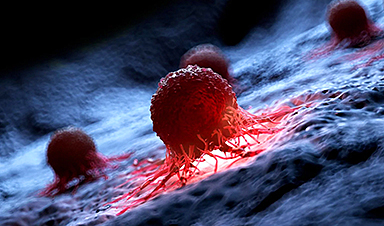A chemical radar allows bacteria to sense and eliminate predators.
Investigating how microorganisms communicate deepens our understanding of the complex ecological interactions that shape our environment is an area of key focus for the Cluster of Excellence “Balance of the Microverse.” A research team from the Cluster, based at the Leibniz Institute for Natural Product Research and Infection Biology – Hans Knöll Institute (Leibniz-HKI) and Friedrich Schiller University Jena, has examined the interactions between amoebae, bacteria, and plants.
Researchers from the University of Bayreuth also contributed to the study. The findings pave the way for discovering new bioactive natural products.
The persistent plant pathogen and a single-celled organism with team spirit
The bacterium Pseudomonas syringae is a ubiquitous and devastating plant pathogen. The pathogen penetrates the plant via natural openings or injuries, infects it, and causes considerable damage in agriculture. Amoebae are natural enemies of the bacterium. The amoeba Polysphondylium pallidum, for instance, is a single-celled organism that feeds on bacteria.
However, if food becomes scarce, the unicellular organisms aggregate to form multicellular structures that allow for the generation and dispersal of spores. While not directly involved in the infection process of the plant, the amoeba is an important predator that forces the bacterium to evolve highly effective defense mechanisms in order to survive in their presence.
An amoeba kills itself
The research team led by Pierre Stallforth, professor at the University of Jena and head of department at the Leibniz-HKI, has now identified a previously unknown defense mechanism of Pseudomonas syringae.
“We were able to show how the bacterium uses a chemical radar to recognize and eliminate the hostile amoebae. Interestingly, the amoebae themselves play a crucial role in their own demise,” says Shuaibing Zhang, first author of the study.
Pierre Stallforth adds: “Pseudomonas syringae produces syringafactins. These are chemical compounds that are harmless to the amoeba, they enable the bacterium to move faster. When the amoeba encounters this molecule, the organism modifies syringafactin’s chemical structure. The bacterium in turn has a special sensor protein – the Chemical Radar Regulator (CraR) – which recognizes these modified molecules. This enables the bacteria to detect the presence of amoebae, whereupon genes responsible for the production of toxic substances – the pyrofactins – are activated. The pyrofactins in turn kill amoebae and, interestingly, are derivatives of the modified syringafactins.”
Defense mechanism provides opportunities for the development of new drugs
The infectivity of the bacterium is also linked to the chemical radar system: P. syringae can only infect thale cress, Arabidopsis thaliana, a very common plant model organism, in the presence of amoebae if the bacterium has an active “chemical radar” and is, therefore, able to defend itself against the predator.
The study provides valuable insights into the complex interplay between microorganisms, protozoa, and higher plants. It also provides starting points for the discovery of new bioactive natural substances that can be useful to humans as drugs or in pest control.
Reference: “A chemical radar allows bacteria to detect and kill predators” by Shuaibing Zhang, Kevin Schlabach, Victor Hugo Pérez Carrillo, Anan Ibrahim, Shahran Nayem, Anna Komor, Ruchira Mukherji, Somak Chowdhury, Lisa Reimer, Felix Trottmann, A. Corina Vlot, Christian Hertweck, Ute A. Hellmich and Pierre Stallforth, 2 April 2025, Cell.
DOI: 10.1016/j.cell.2025.02.033
Numerous fundings made this pioneering study possible under the direction of the Leibniz-HKI, including the Werner Siemens Foundation, the German Research Foundation within the Cluster of Excellence “Balance of the Microverse” and the ChemBioSys Collaborative Research Center. The states of Hessen and Thuringia also supported the project with funding from the European Regional Development Fund (EFRE).
News
A Grain of Brain, 523 Million Synapses, Most Complicated Neuroscience Experiment Ever Attempted
A team of over 150 scientists has achieved what once seemed impossible: a complete wiring and activity map of a tiny section of a mammalian brain. This feat, part of the MICrONS Project, rivals [...]
The Secret “Radar” Bacteria Use To Outsmart Their Enemies
A chemical radar allows bacteria to sense and eliminate predators. Investigating how microorganisms communicate deepens our understanding of the complex ecological interactions that shape our environment is an area of key focus for the [...]
Psychologists explore ethical issues associated with human-AI relationships
It's becoming increasingly commonplace for people to develop intimate, long-term relationships with artificial intelligence (AI) technologies. At their extreme, people have "married" their AI companions in non-legally binding ceremonies, and at least two people [...]
When You Lose Weight, Where Does It Actually Go?
Most health professionals lack a clear understanding of how body fat is lost, often subscribing to misconceptions like fat converting to energy or muscle. The truth is, fat is actually broken down into carbon [...]
How Everyday Plastics Quietly Turn Into DNA-Damaging Nanoparticles
The same unique structure that makes plastic so versatile also makes it susceptible to breaking down into harmful micro- and nanoscale particles. The world is saturated with trillions of microscopic and nanoscopic plastic particles, some smaller [...]
AI Outperforms Physicians in Real-World Urgent Care Decisions, Study Finds
The study, conducted at the virtual urgent care clinic Cedars-Sinai Connect in LA, compared recommendations given in about 500 visits of adult patients with relatively common symptoms – respiratory, urinary, eye, vaginal and dental. [...]
Challenging the Big Bang: A Multi-Singularity Origin for the Universe
In a study published in the journal Classical and Quantum Gravity, Dr. Richard Lieu, a physics professor at The University of Alabama in Huntsville (UAH), which is a part of The University of Alabama System, suggests that [...]
New drug restores vision by regenerating retinal nerves
Vision is one of the most crucial human senses, yet over 300 million people worldwide are at risk of vision loss due to various retinal diseases. While recent advancements in retinal disease treatments have [...]
Shingles vaccine cuts dementia risk by 20%, new study shows
A shingles shot may do more than prevent rash — it could help shield the aging brain from dementia, according to a landmark study using real-world data from the UK. A routine vaccine could [...]
AI Predicts Sudden Cardiac Arrest Days Before It Strikes
AI can now predict deadly heart arrhythmias up to two weeks in advance, potentially transforming cardiac care. Artificial intelligence could play a key role in preventing many cases of sudden cardiac death, according to [...]
NanoApps Medical is a Top 20 Feedspot Nanotech Blog
There is an ocean of Nanotechnology news published every day. Feedspot saves us a lot of time and we recommend it. We have been using it since 2018. Feedspot is a freemium online RSS [...]
This Startup Says It Can Clean Your Blood of Microplastics
This is a non-exhaustive list of places microplastics have been found: Mount Everest, the Mariana Trench, Antarctic snow, clouds, plankton, turtles, whales, cattle, birds, tap water, beer, salt, human placentas, semen, breast milk, feces, testicles, [...]
New Blood Test Detects Alzheimer’s and Tracks Its Progression With 92% Accuracy
The new test could help identify which patients are most likely to benefit from new Alzheimer’s drugs. A newly developed blood test for Alzheimer’s disease not only helps confirm the presence of the condition but also [...]
The CDC buried a measles forecast that stressed the need for vaccinations
This story was originally published on ProPublica, a nonprofit newsroom that investigates abuses of power. Sign up to receive our biggest stories as soon as they’re published. ProPublica — Leaders at the Centers for Disease Control and Prevention [...]
Light-Driven Plasmonic Microrobots for Nanoparticle Manipulation
A recent study published in Nature Communications presents a new microrobotic platform designed to improve the precision and versatility of nanoparticle manipulation using light. Led by Jin Qin and colleagues, the research addresses limitations in traditional [...]
Cancer’s “Master Switch” Blocked for Good in Landmark Study
Researchers discovered peptides that permanently block a key cancer protein once thought untreatable, using a new screening method to test their effectiveness inside cells. For the first time, scientists have identified promising drug candidates [...]




















